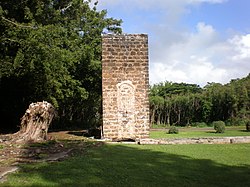Old Sugar Mill of Koloa
|
Old Sugar Mill of Kōloa
|
|

Brick chimney of Old Sugar Mill
|
|
| Location | Maluhia and Kōloa Roads, Kōloa |
|---|---|
| Coordinates | 21°54′35″N 159°28′9″W / 21.90972°N 159.46917°WCoordinates: 21°54′35″N 159°28′9″W / 21.90972°N 159.46917°W |
| Built | 1839–1841 |
| NRHP Reference # | 66000296 |
| Significant dates | |
| Added to NRHP | October 15, 1966 |
| Designated NHL | December 29, 1962 |
The Old Sugar Mill of Kōloa was part of the first commercially successful sugarcane plantation in Hawaiʻi, which was founded in Kōloa on the island of Kauai in 1835 by Ladd & Company. This was the beginning of what would become Hawaii's largest industry. The building was designated a National Historic Landmark on December 29, 1962. A stone chimney and foundations remain from 1840.
Although sugarcane had been raised by ancient Hawaiians on small personal plots, this was the first large-scale commercial production in Hawaii. Joseph Goodrich of the Hilo mission and Samuel Ruggles of the Kona Mission had experimented with using agriculture to support their missions as well as give employment to their students. After trying unsuccessfully to get Rev. Goodrich, Hooper moved to the land as manager, despite having no training in engineering nor agriculture.
The plantation was established here due to the overall fertility of the soil, proximity to a good port, and location near the Maulili pool which allowed them the use of a waterfall for processing power. This first lease was not easily acquired and connections to missionaries played a large part in its acquisition. Previously molasses would end up being distilled into rum, which the conservative missionaries were constantly battling. The founders of Ladd & Co. were William Ladd (1807–1863), Peter A. Brinsmade (1804–1859), and William Northey Hooper (1809–1878).Hawaiians resisted the lease of the land and initially forbade the sale of provisions to plantation managers. The two groups eventually struck an uneasy partnership that resulted in multiple conflicts as time progressed.
Although 980 acres (400 ha) were leased from King Kamehameha III, only 12 acres (4.9 ha) were planted in September 1835. A small mill powered by water from Maulili pool produced a small amount of molasses in 1836. The wooden rollers in the mill quickly wore out, so were replaced with iron ones for increased production. By 1837, the mill produced over 4,000 pounds (1,800 kg) of sugar and 700 US gallons (2,600 l) of molasses. A subsequent mill, whose chimney and foundation are still visible, was built from 1839 to 1841 on Waihohonu Stream. It cost close to US$16,000 to build.
...
Wikipedia

